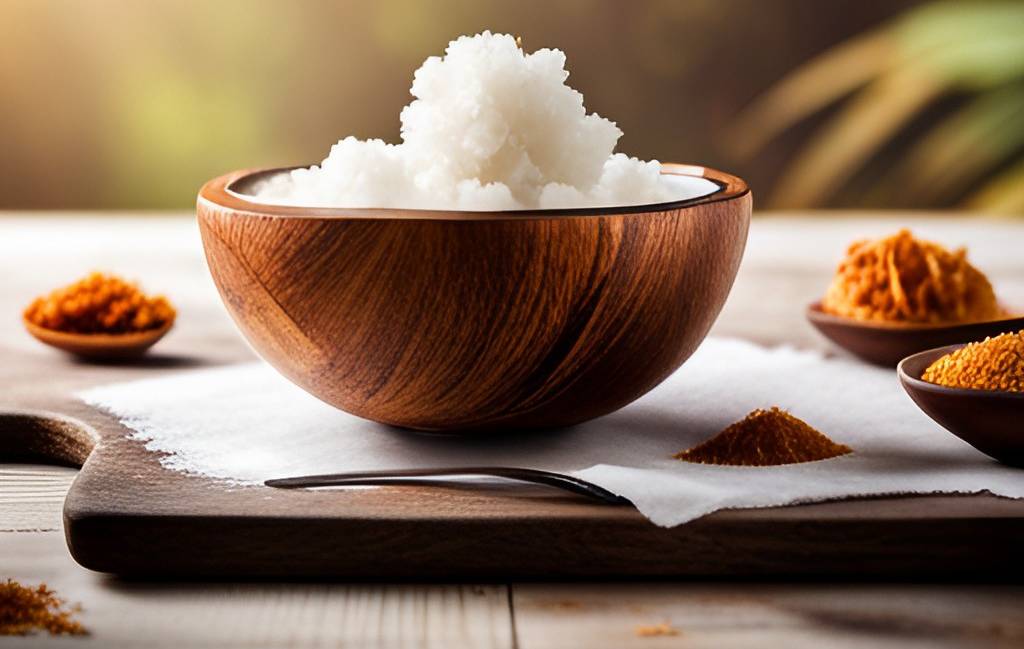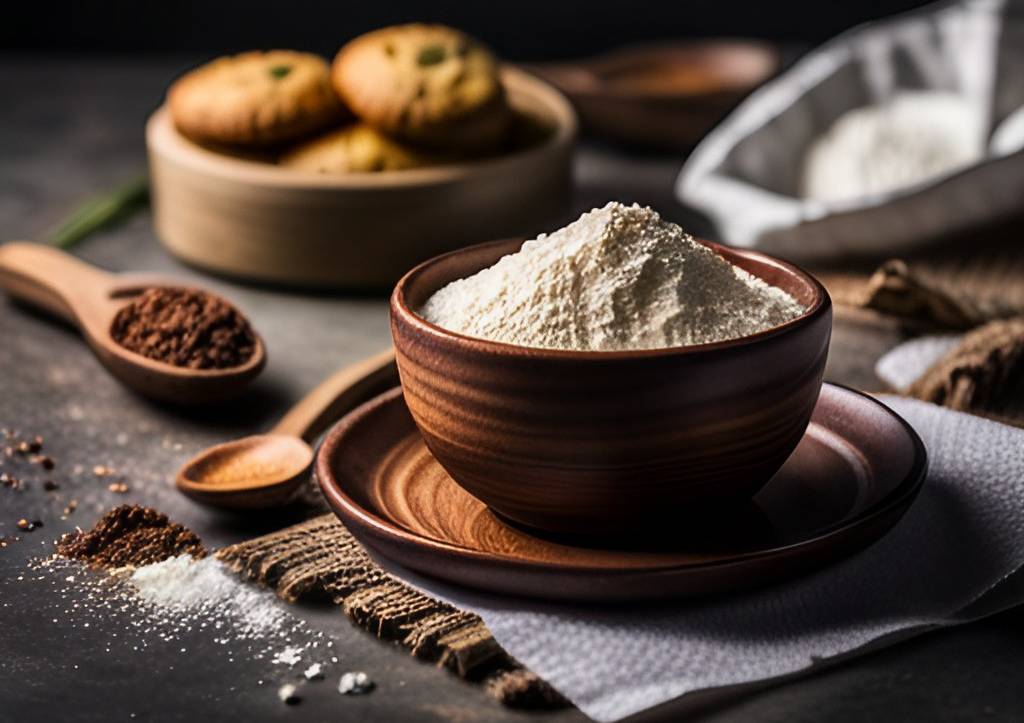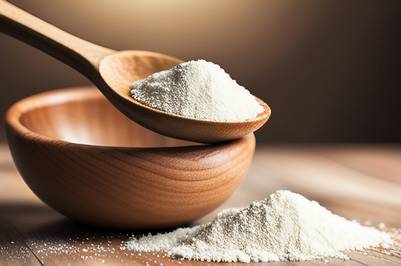|
Search Term: " Savory "
The Versatility of Coconut Sugar: A Dive into its Culinary Uses, Glycemic Index, and Nutritional Profile
Date:
June 05, 2024 03:40 PM
The Versatility of Coconut Sugar: A Dive into its Culinary Uses, Glycemic Index, and Nutritional ProfileIn the world of health-conscious eating, coconut sugar has been gaining traction as a natural sweetener that boasts several benefits over traditional table sugar. Derived from the sap of coconut palm tree flowers, coconut sugar offers a unique flavor and versatile uses in a variety of culinary applications. This article delves into the numerous ways coconut sugar can be utilized in the kitchen, its glycemic index, and its nutritional profile, shedding light on why this sweetener has captured the hearts of many health enthusiasts.
Culinary Uses of Coconut SugarBaking and DessertsOne of the most popular ways to incorporate coconut sugar into your diet is through baking. Coconut sugar can be used as a one-to-one replacement for white or brown sugar in recipes, making it an easy swap for those looking to reduce their intake of refined sugars. Its caramel-like flavor enhances the taste of cookies, cakes, muffins, and other baked goods. For example, coconut sugar can add depth to chocolate chip cookies or provide a rich, molasses-like sweetness to gingerbread.
BeveragesCoconut sugar can also be a delightful addition to both hot and cold beverages. It easily dissolves in liquids, making it a great sweetener for coffee, tea, smoothies, and even cocktails. For instance, adding a spoonful of coconut sugar to your morning coffee or afternoon chai tea can give your drink a subtle, tropical sweetness without the overpowering taste that sometimes accompanies artificial sweeteners.
Cooking and SaucesIn the realm of Savory dishes, coconut sugar works exceptionally well in marinades, sauces, and dressings. Its ability to balance flavors makes it a staple in many Asian cuisines, particularly in Thai cooking. Use it to create a luscious teriyaki sauce or add it to a spicy barbecue marinade. Coconut sugar’s mild sweetness can complement and enhance the umami elements of soy sauce, ginger, and garlic, resulting in a harmonious blend of flavors.
Toppings and CondimentsDon’t overlook coconut sugar as a topping for breakfast or snacks. Sprinkle it over oatmeal, yogurt, or fresh fruit for a burst of flavor and a touch of sweetness. You can also use coconut sugar in homemade granola or energy bars. Its granular texture adds a pleasant crunch, and its rich taste pairs well with nuts, seeds, and dried fruits.
Glycemic IndexOne of the significant advantages of coconut sugar is its lower glycemic index (GI) compared to regular table sugar. The glycemic index is a measure of how quickly a food raises blood sugar levels after consumption. Foods with a high GI can cause rapid spikes and crashes in blood sugar levels, which can be particularly problematic for individuals with diabetes or those managing their weight. Coconut sugar has a GI of approximately 35, which is considerably lower than the GI of table sugar, which hovers around 60-65. This lower GI means that coconut sugar causes a slower, more gradual rise in blood sugar levels. As a result, it can help maintain more stable energy levels throughout the day and prevent the sudden energy crashes that often follow high-sugar snacks or meals.
Nutritional ProfileAside from its lower glycemic index, coconut sugar also offers a more nutrient-dense alternative to refined sugars. While it is still a type of sugar and should be consumed in moderation, coconut sugar contains trace amounts of vitamins and minerals that can contribute to overall health.
Vitamins and MineralsCoconut sugar retains some of the nutrients found in the coconut palm sap. These include small amounts of iron, zinc, calcium, and potassium, all of which play crucial roles in maintaining bodily functions. For example, iron is essential for oxygen transport in the blood, while calcium supports bone health.
AntioxidantsCoconut sugar also contains antioxidants, which help combat oxidative stress and reduce the risk of chronic diseases. Antioxidants can neutralize free radicals, unstable molecules that can damage cells and contribute to aging and diseases like cancer and heart disease.
Inulin ContentAnother noteworthy component of coconut sugar is inulin, a type of dietary fiber. Inulin acts as a prebiotic, feeding the beneficial bacteria in the gut and promoting a healthy digestive system. Its presence in coconut sugar can further contribute to its lower glycemic index by slowing down glucose absorption.
Choosing and Storing Coconut SugarWhen purchasing coconut sugar, it’s essential to select high-quality brands that don’t mix the sugar with other sweetening agents like cane sugar. Always check the label to ensure you’re buying 100% pure coconut sugar.
Storage TipsStore coconut sugar in an airtight container in a cool, dry place to maintain its texture and flavor. It’s important to keep it away from moisture, as this can cause clumping and affect its usability.
Ready to Sweeten up Your Life?Coconut sugar presents a versatile and nutritious alternative to traditional sweeteners, offering a wide range of culinary uses while providing a lower glycemic index and additional vitamins and minerals. Whether you’re baking your favorite dessert, sweetening your morning coffee, or enhancing a Savory dish, coconut sugar can be a valuable addition to your pantry. Its unique flavor and health benefits make it an excellent choice for those looking to enjoy sweetness in a more wholesome form. By understanding and embracing the versatility of coconut sugar, you can make more informed and health-conscious decisions in your culinary endeavors.
(https://vitanetonline.com:443/forums/Index.cfm?CFApp=1&Message_ID=6612) Stevia: A Zero-Calorie Sweetener
Date:
June 03, 2024 04:15 PM
Stevia: A Zero-Calorie SweetenerIn a world where health consciousness is increasingly important, finding the right sweetener can be a game changer. One such alternative that has gained significant attention is Stevia. Known for its zero-calorie content, Stevia offers a natural sweetness without the drawbacks associated with sugar. This article examines the properties of Stevia, how it’s harvested, its sweetness compared to sugar, and its benefits for those managing diabetes.
What is Stevia?Stevia is a natural sweetener derived from the leaves of the Stevia rebaudiana plant, native to South America. Unlike artificial sweeteners, Stevia is completely natural and has been used for centuries by indigenous people in countries like Brazil and Paraguay. The leaves of the plant contain sweet-tasting compounds known as steviol glycosides, which are the primary components used in Stevia sweeteners found on shelves today.
How Stevia is HarvestedTraditionally, Stevia leaves are harvested by hand. Farmers usually pluck the mature leaves, which are then dried to maintain their sweetness. Once dried, these leaves can be used in their whole form, or they can be processed to extract the steviol glycosides. Modern extraction methods involve soaking the leaves in water and then processing the extract to remove impurities. This results in a highly concentrated sweetener that is hundreds of times sweeter than sugar.
Sweetness Compared to SugarWhen it comes to sweetness, Stevia stands out. Stevia is approximately 200 to 300 times sweeter than sucrose (table sugar). This means a very small amount of Stevia is needed to achieve the desired level of sweetness, which also makes it an efficient option for those looking to cut down on sugar intake. However, it’s important to note that Stevia doesn’t have the exact same taste profile as sugar. Some people describe its sweetness as having a slight, licorice-like aftertaste, which not everyone finds appealing.
Benefits for Those Managing DiabetesFor individuals managing diabetes, Stevia can be an invaluable part of their diet. One of the primary concerns for people with diabetes is managing their blood sugar levels. Traditional sugar can cause spikes in blood glucose, making it difficult to control diabetes symptoms. Stevia, on the other hand, does not contain carbohydrates and has no impact on blood glucose levels. This makes it a suitable alternative for those who need to keep their sugar levels in check. Moreover, using Stevia can help diabetic individuals enjoy sweet foods and beverages without the fear of negatively affecting their health. The zero-calorie aspect of Stevia also contributes to maintaining a healthier weight, which is a crucial factor in managing diabetes.
Nutritional and Health BenefitsIn addition to its zero-calorie feature, Stevia also offers several nutritional and health benefits. Some research suggests that Stevia may help in lowering blood pressure and improving cholesterol levels. These potential benefits make Stevia not just a sugar substitute, but a supplement that can contribute to overall well-being.
Antioxidant PropertiesStevia leaves are rich in antioxidants, which help to combat oxidative stress in the body. Oxidative stress is linked to various chronic diseases, including heart disease and cancer. By incorporating Stevia into your diet, you might benefit from its antioxidant content, aiding in the reduction of inflammation and promoting better health.
Culinary UsesStevia is versatile and can be used in a variety of culinary applications. It’s available in different forms such as powders, liquid extracts, and even whole leaves. You can use Stevia to sweeten beverages like tea and coffee, baked goods, desserts, and even Savory dishes that require a touch of sweetness. However, due to its high sweetness level, it is recommended to start with a small amount and adjust according to taste. Keep in mind that Stevia might behave differently than sugar in recipes, particularly in baking. Sugar contributes to the texture and volume of baked goods, while Stevia does not. Therefore, recipes using Stevia may require additional adjustments for the best results.
Economic and Environmental ImpactGrowing and harvesting Stevia can be advantageous from both economic and environmental perspectives. Stevia plants require less land and water compared to sugar cane or beet crops, making it a more sustainable option in the long run. Additionally, Stevia farming can provide economic opportunities for communities in developing countries where the plant is grown.
Are You Ready For a Zero-Calorie Sweetener?Stevia stands out as an exceptional zero-calorie sweetener, especially beneficial for those managing diabetes and looking to reduce their calorie intake. Its natural origin, coupled with its impressive sweetness and array of health benefits, make it a compelling alternative to traditional sugar and artificial sweeteners. Whether you are looking to alter your dietary habits or manage a health condition like diabetes, Stevia offers a promising solution for a healthier sweetening choice.
(https://vitanetonline.com:443/forums/Index.cfm?CFApp=1&Message_ID=6610) Culinary Uses of Stevia: Sweeten Your Dishes Without Compromising Flavor
Date:
May 30, 2024 12:46 PM
Culinary Uses of Stevia: Sweeten Your Dishes Without Compromising FlavorStevia has garnered attention as a natural, calorie-free sweetener that can seamlessly replace sugar in various recipes. Derived from the leaves of the Stevia rebaudiana plant, this sweetener is known for its ability to provide a satisfying sweetness without the health drawbacks associated with traditional sugar. In this article, we'll explore creative recipes and practical tips for incorporating stevia into everyday cooking and baking, allowing you to enjoy your favorite dishes without compromising on taste.
Benefits of Using SteviaBefore diving into recipes, it's important to understand why stevia is a fantastic alternative to sugar. Here are some of the key benefits:
Baking with SteviaStevia can effectively replace sugar in many baking recipes, but it's essential to remember that it is much sweeter than sugar. Typically, a teaspoon of stevia extract can replace a cup of sugar, but always refer to specific conversion charts provided by stevia product manufacturers.
Stevia-Sweetened Chocolate Chip CookiesIngredients:
Instructions:
Cooking with SteviaBeyond baking, stevia can introduce a hint of sweetness to Savory dishes as well. Here are some innovative ways to include stevia in your everyday cooking.
Stevia BBQ SauceIngredients:
Instructions:
Drinks and SmoothiesStevia is also great for sweetening beverages. Whether it’s a refreshing iced tea or a nutritious smoothie, stevia can add the perfect touch of sweetness.
Stevia LemonadeIngredients:
Instructions:
Tips for Cooking with Stevia
Stevia opens up a world of culinary possibilities, letting you enjoy the sweetness of your favorite recipes without the drawbacks of sugar. From delectable desserts like chocolate chip cookies to Savory innovations like homemade BBQ sauce, the versatility of stevia can enhance all your culinary creations. Remember, the key is to experiment and adapt recipes to suit your taste, making stevia a valuable and enjoyable part of your cooking repertoire.
(https://vitanetonline.com:443/forums/Index.cfm?CFApp=1&Message_ID=6606) All You Need to Know About Kal brand Stevia: The Natural Sweetener that is Way Better than Sugar!
Date:
August 09, 2023 02:11 PM
What is Stevia? stevia is an all-natural, non-GMO, and calorie-free sweetener made from the leaves of the Stevia rebaudiana plant. It's a safe alternative to sugar that doesn't raise your blood sugar levels and has a 0 glycemic index. Its sweet taste comes from steviol glycosides, which are extracted from the leaves and purified. Stevia is commonly used to sweeten drinks, baked goods, and even Savory dishes. How is Stevia Different from Other Sweeteners? Unlike artificial sweeteners such as aspartame and saccharin, stevia is a natural sweetener that doesn't have any of the negative health effects that come with consuming artificial additives. It's a safer option to sugar that doesn't affect insulin levels, making it beneficial for diabetics or those who are watching their sugar intake. Additionally, stevia has a much sweeter taste compared to traditional sugar, so only a small amount is needed to achieve the desired sweetness. How to Use Stevia? Stevia can be used in the same way as sugar when baking or cooking, but with way less quantity. For example, if a recipe calls for 1 cup of sugar, just 1/2 teaspoon of Kal stevia will give the equivalent sweetness. However, it's important to keep in mind that stevia can taste slightly different from sugar and may not always be an exact substitute. Start with smaller amounts and increase as needed and you'll get the hang of it. Are There Any Side Effects of Stevia? Stevia has been used worldwide and is found to be one of the safest all natural sweetener on the market. There have been no known negative side effects associated with the use of stevia other than the potential for mild gastrointestinal symptoms if consumed in large amounts. Generally, most don't consume enough to cause any issues. Stevia comes in powder and liquid forms. Liquid tends to mix instantly and is preferred by most people. If you're looking to reduce your sugar intake while still satisfying your sweet tooth, Kal brand stevia may be an excellent alternative for you. With its natural origins, numerous health benefits, and delicious taste, it's not hard to see why so many people are switching over to this sweetener over the traditional chemical-laden sugars of the past. Try Kal brand stevia in your next recipe or tea and let your taste buds be the judge! If your interested, just add to cart for best price!
(https://vitanetonline.com:443/forums/Index.cfm?CFApp=1&Message_ID=6584) NOW Real Food® Marcona Almonds
Date:
November 02, 2022 04:44 PM
Almonds are a popular ingredient in many Mediterranean dishes. They are originally from Spain and are known for their rich, buttery flavor. Our Marcona almonds are grown in California on a family farm. They are blanched to preserve their pure, mild, buttery flavor and moist, tender texture. Here are some ways you can enjoy them! Salads - Add some crunch to your salad with NOW Real Food® Marcona Almonds. Their rich, buttery flavor goes great with greens and other salad ingredients. Desserts - Use Marcona Almonds as a topping for your favorite dessert. They add a delicious crunch that takes your dessert to the next level. Cheese and Fruit Pairings - Serve NOW Real Food® Marcona Almonds with cheese and fruit for a tasty snack or appetizer. The rich, buttery flavor of the almonds pairs well with both sweet and Savory flavors. NOW Real Food® Marcona Almonds are a versatile ingredient that can be used in many different dishes. Their rich, buttery flavor is perfect for salads, desserts, and cheese and fruit pairings. Add them to your next dish for a delicious crunch that will take it to the next level!
(https://vitanetonline.com:443/forums/Index.cfm?CFApp=1&Message_ID=6554) Discover the sweetness of monk fruit
Date:
October 21, 2022 12:34 PM
Are you looking for a zero calorie sweetener that is significantly sweeter than sugar? Look no further than monk fruit, also known as Luo Han Guo. Monk fruit is amazing because it is up to 200 times as sweet as sugar and can be used as a fantastic alternative to sugar in beverages. What Is Monk Fruit? Monk fruit, also known by its Chinese name Luo Han Guo, is a small, green melon that grows in Southeast Asia. It has been used for centuries in traditional Chinese medicine and only recently gained popularity as a zero-calorie natural sweetener. The sweetness of monk fruit comes from mogrosides, which are unique antioxidants that are heat stable and do not break down when exposed to cooking or baking temperatures. This means that monk fruit can be used in a wide variety of recipes, both sweet and Savory! How to Use Monk Fruit You can buy monk fruit sweetener in both liquid and powder form at VitaNet LLC. If you have been looking for a zero calorie natural sweetener that is much sweeter than sugar, try monk fruit! Monk fruit comes in both liquid and powder form and can be easily substituted for sugar in any recipe.
(https://vitanetonline.com:443/forums/Index.cfm?CFApp=1&Message_ID=6515) Used in moderation, nutritional yeast can boost immunity andimprove digestion
Date:
May 17, 2019 09:33 AM
Nutritional yeast, with the scientific name Saccharomyces cerevisiae, is sometimes called nooch and is made from beet molasses and sugar cane. This yeast uses sugar for energy in its yeast cells and are believed to help improve digestion. It is rich in nutrients and B vitamins like vitamin B1, B2, B3 and B6 and can also give a rich, nutty, and savory flavor to food; that is why vegans and vegetarians use it often. Even non-vegans can use it for its high nutritional content. It is noted that only fortified nutritional yeast contains the added B vitamins since unfortified yeast contains the vitamins that were produced by the yeast itself but one can buy both the fortified and unfortified varieties and blend them together. It is naturally low in sodium and calories. It is also free of fat, free of gluten, free of sugar and as I said before, vegan. Properly stored it can last for up to two years in the home. Some of the health benefits of nutritional yeast are that it boosts immunity, improves digestion, is a vegan source of vitamin B12 and lowers cholesterol and blood pressure. Key Takeaways:
"Vegans and vegetarians use nutritional yeast because it is rich in nutrients and B vitamins, but you can also add it to your diet if you are looking for a natural ingredient with a cheesy, nutty, and savory flavor." Read more: https://www.naturalnews.com/2019-04-04-used-in-moderation-nutritional-yeast-can-boost-immunity-and-improve-digestion.html
(https://vitanetonline.com:443/forums/Index.cfm?CFApp=1&Message_ID=6327) 5 powerful reasons to start eating garlic TODAY
Date:
April 23, 2019 02:41 PM
Garlic is an essential ingredient in many kitchens, and also demonstrates an impressive array of health benefits. For example, garlic can encourage higher production of hydrogen sulfide, which helps to keep your blood vessels open and supple, reducing your risk of heart disease. Garlic can help mitigate metabolic syndrome and reduce your risk of several types of cancer, including stomach cancer. By neutralizing enzymes that help break down bone, garlic may also help to ward off osteoarthritis, too. Key Takeaways:
"Garlic, a member of the onion family, has a centuries-long history of medicinal use on a global scale." Read more: https://www.naturalhealth365.com/garlic-heart-disease-2766.html
(https://vitanetonline.com:443/forums/Index.cfm?CFApp=1&Message_ID=6162) Researchers reveal how the common curry spice turmeric kills coloncancer cells
Date:
April 19, 2019 02:20 PM
Studies are now showing that turmeric, which is a common spice found in curry, can actually help kill off colon cancer cells to help the disease from progressing. They believe that these healing properties are due to the curcumin content that is found within the spice itself. If you're searching for ways to take in adequate amounts of turmeric, try consuming turmeric tea. For a more savory option, turmeric tastes fantastic when sprinkled on roasted produce. Key Takeaways:
"In this study, published in the journal Nutrition Research, the researchers hypothesized that curcumin-induced ROS works against colon cancer by promoting apoptosis and inhibiting the cell cycle. They tested this through in vitro experiments involving Smd4 and p53 mutated HT-29 colon adenocarcinoma cells." Read more: https://www.naturalnews.com/2019-02-27-common-curry-spice-turmeric-kills-colon-cancer-cells.html
(https://vitanetonline.com:443/forums/Index.cfm?CFApp=1&Message_ID=6143) The Best Teas For Every Ailment, From Anxiety To Bloating To Inflammation
Date:
October 09, 2017 10:14 AM
Tea can help with a lot of ailments. The herbs they are made with contain many nutrients and have medicinal properties. This is how our ancestors treated almost everything. This is great info on the right teas for many situations. If you want to try this instead of taking medications you should be able to get started with what you learn here. There are also many books and wbesites with more information for you to explore. Key Takeaways:
"A relative to turmeric, ginger lends a satisfying zing and bright note to all kinds of sweet and savory dishes." Read more: https://www.mindbodygreen.com/articles/the-best-teas-for-anxiety-bloating-and-inflammation
(https://vitanetonline.com:443/forums/Index.cfm?CFApp=1&Message_ID=5322) Eight fat-burning foods already in your kitchen
Date:
March 13, 2017 02:45 PM
A lot of people want to lose weight by working out but, what they fail to realize is that eating right is a huge factor for trying to lose weight. Working out will burn carbs but so will certain foods in your diet as well. The article mentions a group of eight foods people should incorporate that will help you burn fat. The lists contains a variety of foods that some will never think will even help to lose weight to begin with. Key Takeaways:
"Many of the foods recommended in the list below have what's known as a thermogenic effect." Read more: https://www.google.com/url?rct=j&sa=t&url=http%3A%2F%2Fwww.nzherald.co.nz%2Flifestyle%2Fnews%2Farticle.cfm%3Fc_id%3D6%26objectid%3D11812837&ct=ga&cd=CAIyGmZjNGVlYTM1NDU3YmZmOGU6Y29tOmVuOlVT&usg=AFQjCNGlPrw_OgI1GCo5alsL4NwFKGl_Mg
(https://vitanetonline.com:443/forums/Index.cfm?CFApp=1&Message_ID=4138) Why you should consider eating these insects this holiday season
Date:
February 15, 2017 10:59 AM
In many places around the globe insects are part of people's regular diet. This is called Entomophagy. It has many benefits for the environment and for the individuals who practice it, including a high protein content compared to other food sources. Find out the unbelievable in this absolutely amazing and crazy article! Key Takeaways:
"Different ants have different flavors -- from sweet to Savory - but for Lemann they are a nice way to introduce skeptics to a bug meal." Reference: //www.cnn.com/2016/12/23/health/gallery/eating-bugs-dishes/index.html
(https://vitanetonline.com:443/forums/Index.cfm?CFApp=1&Message_ID=3947) If You Eat Garlic And Honey On An Empty Stomach For 7 Days This Is What Happens To Your Body
Date:
February 11, 2017 10:19 AM
Garlic and honey may seem like odd ingredients to put together, but combining them results in an impressive immune-boosting substance that will keep your body healthy and strong. Not only is garlic the perfect choice for adding flavor to a Savory recipe it provides a long list of health benefits thanks to its powerful antioxidant properties. https://www.youtube.com/watch?v=G7pTi-Re64MKey Takeaways:
"Garlic and honey may seem like odd ingredients to put together, but combining them result in a impressive immune boosting substance."
(https://vitanetonline.com:443/forums/Index.cfm?CFApp=1&Message_ID=3922) The top 10 worst ingredients found everywhere across the survival foods industry
Date:
November 16, 2016 04:49 PM
Survival foods sometimes have ingredients that are not as healthy as you may think. Many foods from companies like WISE Foods or Mountain House are actually full of chemicals and harmful ingredients. Some of the ingredients include corn syrup solids, modified corn starch or Disodium Inosinate. There is a healthier option for survival foods though--Organic Family Pack from Numanna. This option is GMO free and free of chemical preservatives. Key Takeaways:
"Long-term storable foods are one of the preparation items you should be considering and buying." Reference: //www.naturalnews.com/055891_survival_food_Organic_Family_Pack_Numanna.html
(https://vitanetonline.com:443/forums/Index.cfm?CFApp=1&Message_ID=3456) Clantro (Coriander Plant) to remove heavy metals
Date:
November 05, 2009 01:51 PM
Cilantro Heavy Metal Detox With Chlorella
Planetary Herbals Cilantro heavy metal detox contains organic cilantro leaf and organic chlorella, for the purest product possible. Herbs: Nature’s Answer to a Toxic World Cilantro (one of the names used for the leaves of the coriander plant, Coriandrum sativum) is an ancient herb that has been used for millennia for health and for its robust, Savory taste. Beyond its culinary value, modern research has confirmed the benefits of cilantro as a natural means of internal cleansing.
Recent studies show the cilantro attaches to heavy metals in the bloodstream. This process, known as “Chelation,” helps our bodies eliminate metals from our systems, and helps cleanse and purify our tissues, organs and blood. This process is supported with the addition of chlorella, single celled algae that work synergistically to enhance cilantro’s chelating and cleansing ability. Binding heavy metals Thousands of noxious chemical compounds, many of which didn’t exist on the planet 100 years ago, now pervade our food, water, and air. Heavy metals like lead, mercury, arsenic, aluminum, and cadmium enter our bodies through food, air, cooking utensils, deodorant, and even the fillings in our teeth. Cilantro’s properties that enable binding with these toxins are thought to come from unique constituents, including citric acid, phytic acid, and electrolytes that attach to metals. The sequestration of metal ions by chlorella is assumed to be accomplished by surface ligands in the cell walls. Simply stated, both cilantro and chlorella contain properties that bind with metals, and chlorella additionally helps purge the bound metals from the organs. Planetary Herbals: the PhytoDynamic Difference Cilantro heavy metal detox is the latest in a herbal product line based on the principles of PhytoDynamics. PhytoDynamics unites a profound understanding of the interaction between plants and people, a commitment to holistic integrity of herbs for optimal efficacy, a strong grounding in scientific research, a world class quality control team, and a level of clinical expertise unmatched in the industry.
(https://vitanetonline.com:443/forums/Index.cfm?CFApp=1&Message_ID=2110) Oregano Complete with Carvacrol
Date:
September 15, 2005 09:58 AM
Introducting Oregano Complete with CarvacrolThe answer to serious Self-Care
Solaray Provides a "Complete" Oregano - not just for pizza anymore ...
The Wild Oregano in the Oregano Complete formula is: 1: An aromatic Phenolic compound found in plants such as oregano and Savory and used in flavorings. 2: Source of the antioxidant and immune function support in oregano. Solaray guarantees that the Wild Oregano oil found in the Oregano Complete formula contains at least 70% Carvacrol - to ensure your customers gain the optimal health benefits from this powerful product. **The Green Screened from the Wild logo represents Solaray's commitment to providing herbs of the utmost quality. The logo distinguished this product because it is wild sourced and as pure as Mother Nature intended.
(https://vitanetonline.com:443/forums/Index.cfm?CFApp=1&Message_ID=783) Cholesterol Conundrum
Date:
June 10, 2005 02:35 PM
Cholesterol Conundrum by Jane Lane Energy Times, February 7, 1999 The cholesterol story packs enough subplots to satisfy a soap opera. There's Cholesterol: The Good, the Bad and the Awful. Cholesterol: The Stalker Behind Every (Restaurant) Door. Cholesterol Steals Your Heart Away-to the Mediterranean. The very image of cholesterol chills the imagination. Lurid and unSavory, it would seem to bob through the bloodstream like blobs of fat congealed on cold soup, slathering itself onto arteries. Cholesterol is in fact a normal, natural substance in our bodies, found in the brain, nerves, liver, blood and bile. Cholesterol is so crucial that each cell is equipped with the means to synthesize its own membrane cholesterol, regulating the fluidity of those membranes when they are too loose or too stiff. We manufacture steroid hormones-the female hormones estrogen and progesterone, and the male hormone testosterone-from cholesterol. Adrenal corticosteroid hormones, which regulate water balance through the kidneys, and the hormone cortisone, the vital anti-inflammatory that also governs our stress response, come from cholesterol. Other jobs of cholesterol: production of vitamin D and bile acid (for the digestive process); healing and protecting skin, and antioxidant compensation when vitamin and mineral stores are low. How can mere mention of this invaluable component in our body chemistry make our blood run cold? Guilt by Association Cholesterol's reputation as a bad character actually originates in the crowd it runs with: the lipoproteins, protein molecules to which it binds in order to travel back and forth through the bloodstream to the liver, where it is manufactured. Not really a nasty round glob of fat at all, cholesterol is a crystalline substance, technically a steroid, but soluble in fats rather than water, thus classified as a lipid, as fats are. Thousands of cholesterol molecules bind with lipoproteins, spherical fat molecules that transport them through the bloodstream. Three different kinds of lipoproteins participate in this necessary process, not always with the same salutary effect. Here's how they work: High-density lipoprotein (HDL): referred to as the "good cholesterol." Carries relatively little cholesterol. Travels through the bloodstream removing excess cholesterol from the blood and tissues. HDLs return the surplus to the liver, where it may once again be incorporated into low-density lipoproteins for redelivery to the cells. Low-density lipoprotein (LDL): the so-called "bad cholesterol," heavily laden with cholesterol, hauling it from the liver to all cells in the body. Ideally, this system should be in balance. But if there is too much cholesterol for the HDLs to pick up, or an inadequate supply of HDLs, cholesterol may aggregate into plaque groups that block arteries. Lipoprotein(a), or Lp(a): the "really bad" cholesterol, can step in, providing the glue that actually sticks to the arterial wall. Lp(a) is an LDL particle with an extra adhesive protein wrapped around it, enabling it to attach fat globules to the walls of blood vessels. The potentially deadly results are atherosclerotic ("plaque") deposits. Simple LDL lacks adhesive power and presents little risk for cardiovascular disease. Researchers confirmed the existence of Lp(a) in the August 1996 issue of the Journal of the American Medical Association, disclosing that high levels of Lp(a) in the blood can double a man's risk of heart attack before age 55. Doctors estimate that about 20% of all Americans carry elevated levels of Lp(a). One troubling aspect of the report, part of the ongoing 40-year-old Framingham Study, concerned the fact that the men who suffered heart attacks entered the project with no signs of heart disease and only slightly elevated cholesterol. But during the 15-year investigation, 129 men out of 2,191 developed premature heart disease. The culprit? High levels of Lp(a) Experts don't know for certain where Lp(a) comes from, or its normal function, although they suspect the body's quotient of Lp(a) is mostly due to your genes. According to the study, they also believe that aspirin, a blood thinner, and red wine (or its grapeseed and skin extracts) may mitigate the damage of Lp(a). That also would explain why the French, who tend to wash down their fat-rich diet with red wine, experience a relatively moderate incidence of cardiovascular disease The Terrible Triglycerides The body also transports fats via triglycerides (TGs), the main form of body fat and the storehouse for energy. Edible oils from seeds, egg yolk and animal fats also are composed chiefly of TGs. Although not as corrosive as LDL, excess TGs intensify heart disease potential when they oxidize and damage artery linings or induce blood cells to clump. An "acceptable" level of triglycerides is thought to be 200 milligrams, although under 150 is probably healthier. And some researchers think your triglyceride reading should be below 100. High triglycerides and low HDL often occur together, increasing the risks of cardiovascular disease, high blood pressure, heart and kidney failure and other degenerative diseases. What To Do About Your Cholesterol Have it checked. High cholesterol alone shows no symptoms. Your health practitioner can perform a laboratory test to measure your levels. Thoroughly share your own medical history and as much as you know about your family members: heredity and related illnesses definitely are important influences. People with diabetes, for example, can have high levels of triglycerides, which also may lead to pancreatitis (painful inflammation of the pancreas) at extremely high levels. According to the National Cholesterol Education Program, a reading of under 200 mg/dL is desirable; 200 to 239 is borderline high; 240 and above is high. Your LDL level should be 130 or under; HDL should not be lower than 35. A triglyceride level below 200 is considered desirable; readings above 400 are high. Adjust your diet. Cholesterol levels are readily controllable, primarily through changes in your diet. Leslie C. Norins, MD, PhD, suggests all-out war in his Doctor's 30-Day Cholesterol Blitz (Advanced Health Institute) with saturated fats, which raise cholesterol more than any other component in your diet, as your number-one target. Out with saturated fats like butter, cheese, whole milk, ice cream, red meat and some vegetable fats found in tropical oils like coconut and palm; in with fruits, vegetables, brown rice, barley (a good source of soluble fiber, the kind that soaks up fats and cholesterol and escorts them out of the body), beans, potatoes and pasta, prepared or dressed with monounsaturated fats in olive and canola oils (the so-called Mediterranean diet concept). Feast on cold-water fish (mackerel, salmon, sardines and herring) rich in omega-3 fatty acids that help reduce serum lipids, among many other healthful advantages. Exercise. Move it and lose it are the words to live by when it comes to cholesterol. Researchers from the Stanford Center for Research in Disease Prevention reported in the July 2, 1998 New England Journal of Medicine (vol. 339, pages 12-20) that a weight-loss diet like that of the National Cholesterol Education Program plus exercise significantly lowered LDL (bad) cholesterol levels for men and postmenopausal women. The diet alone failed to lower LDL in these folks with high-risk lipoprotein. Educate yourself. In addition to your health practitioner, books and magazines can guide you in cholesterol management. A trove of information is the National Cholesterol Education Program (NCEP), launched in 1985 by the National Institute of Health. Their address is: National Cholesterol Education Program, Information Center, P.O. Box 30105, Bethesda, MD 20824-0105; telephone (301) 251-1222; they're on the web at /nhlbi/. Recommended Reading: Fats that Heal, Fats that Kill (Alive, 1993), by Udo Erasmus. Prescription for Nutritional Healing (Avery, 1997), by James F. Balch, MD, and Phyllis A. Balch, CNC. The Healthy Heart Formula (Chronimed, 1997), by Frank Bary, MD. Eradicating Heart Disease (Health Now, 1993), by Matthias Rath, MD.
(https://vitanetonline.com:443/forums/Index.cfm?CFApp=1&Message_ID=266) | ||||||||||||











 Planetary Herbals is pleased to introduce Cilantro heavy metal detox, a unique herbal cleansing formula for defense against today’s environmental toxins. The herbs in Cilantro heavy metal detox are known to bind to heavy metals, helping to clear them from the body. Chlorella is added to increase the chelating and cleansing actions of cilantro. This combination also provides effective antioxidant support for overall cell health.
Planetary Herbals is pleased to introduce Cilantro heavy metal detox, a unique herbal cleansing formula for defense against today’s environmental toxins. The herbs in Cilantro heavy metal detox are known to bind to heavy metals, helping to clear them from the body. Chlorella is added to increase the chelating and cleansing actions of cilantro. This combination also provides effective antioxidant support for overall cell health. 




